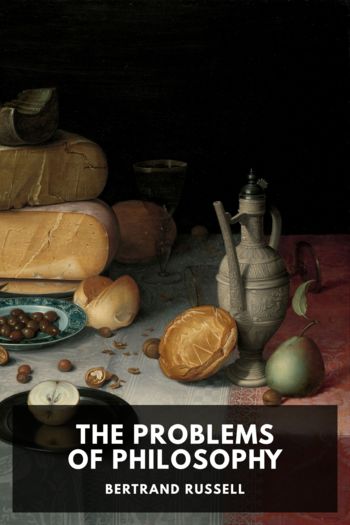The Lives and Opinions of Eminent Philosophers Diogenes Laërtius (first ebook reader .TXT) 📖

- Author: Diogenes Laërtius
Book online «The Lives and Opinions of Eminent Philosophers Diogenes Laërtius (first ebook reader .TXT) 📖». Author Diogenes Laërtius
Lightning precedes thunder, either because it is produced at the same moment that the wind falls on the cloud, while the noise is only heard at the instant when the wind has penetrated into the bosom of the cloud; or, perhaps, the two phenomena being simultaneous, the lightning arrives among us more rapidly than the noise of the thunderbolt, as is in fact remarked in other cases when we see at a distance the clash of two objects.
The thunderbolt may be produced either by a violent condensation of the winds, or by their rapid motion and conflagration. It may arise from the fact of the winds meeting in places which are too dense, in consequence of the accumulation of clouds, and then a portion of the current detaches itself and proceeds towards the lower situations; or else it may be caused by the fire which is contained in the bosom of the clouds precipitating itself downwards. As one may suppose that an immense quantity of fire being accumulated in the clouds dilates, violently bursting the substance which envelops it, because the resistance of the center hinders it from proceeding further. This effect is especially produced in the neighborhood of high mountains; and, accordingly, they are very frequently struck with the thunderbolts. In short, one may give a number of explanations of the thunderbolt; but we ought above all things to be on our guard against fables, and this one will easily be if one follows faithfully the sensible phenomena in the explanation of these things which are not perceived, except indirectly.
Hurricanes (πρηστῆρες) may be caused either by the presence of a cloud which a violent wind sets in motion and precipitates with a spiral movement towards the lower regions, or by a violent gust which bears a cloud into the neighborhood of some other current, or else by the mere agitation of the wind by itself, when air is brought together from the higher regions and compressed without being able to escape on either side, in consequence of the resistance of the air which surrounds it; when the hurricane descends towards the earth, then there result whirlwinds in proportion to the rapidity of the wind that has produced them; and this phenomenon extends over the sea also.
Earthquakes may arise from the wind penetrating into the interior of the earth, or from the earth itself receiving incessantly the addition of exterior particles, and being in incessant motion as to its constituent atoms, being in consequence disposed to a general vibration. That which permits the wind to penetrate is the fact that falls take place in the interior, or that the air being impressed by the winds insinuates itself into the subterraneous caverns. The movement which numberless falls and the reaction of the earth communicate to the earth, when this motion meets bodies of greater resistance and solidity, is sufficient to explain the earthquakes. One might, however, give an account of them in several other ways.
Winds are caused either by the successive and regular addition of some foreign matter, or else by the reunion of a great quantity of water; and the differences of the winds may arise from the fact that some portions of this same matter fall into the numerous cavities of the earth, and are divided there.
Hail is produced by an energetic condensation acting on the ethereal particles which the cold embraces in every direction; or in consequence of a less violent condensation acting however on aqueous particles, and accompanied by division, in such a manner as to produce, at the same time, the reunion of certain elements and of the collective masses; or by the rupture of some dense and compact mass which would explain at the same time, the numerousness of the particles and their individual hardness. As to the spherical form of the hail, one may easily account for that by admitting that the shocks which it receives in every direction make all the angles disappear, or else that at the moment when the different fragments are formed, each of them is equally embraced on all sides by aqueous or ethereal particles.
Snow may be produced by a light vapor full of moisture which the clouds allow to escape by passages intended for that end, when they are pressed in a corresponding manner by other clouds and set in motion by the wind. Subsequently, these vapors become condensed in their progress under the action of the cold which surrounds the clouds in the lower regions. It may also be the case that this phenomenon is produced by clouds of a slight density as they become condensed. In this case the snow which escapes from the clouds would be the result of the contact or approximation of the aqueous particles, which in a still more condensed state produce hail. This effect is most especially produced in the air. Snow, again, may result from the collection of clouds previously condensed and solidified; or from a whole army of other causes.
Dew proceeds from a reunion of particles contained in the air calculated to produce this moist substance. These particles may be also brought from places which are moist or covered with water (for in those places, above all others, it is that dew is abundant). These then reunite,





Comments (0)